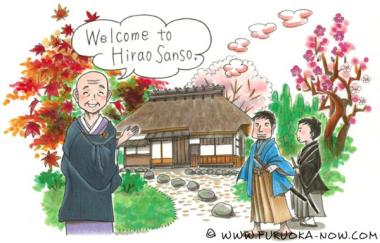Hakata Culture vol.80
Botoni Nomura―Female Poet of the Late Edo Era

Sanso-dori is a street that runs from Ozasa to Hirao in Chuo-ku. The name is derived from Hiraosanso, a thatched-roof hut located nearby. This was the home of Botoni Nomura, a female poet active in the Late Edo era, for 21 years. The hut is located in middle of the city today, but in Nomura's time, it was off the beaten path. Surrounded by nature, she lived a quiet life with her husband writing poems.
But her life changed dramatically after her husband's death. She became a nun, assumed the name Botoni (her given name was Moto) and traveled to Kyoto to study literature. There she witnessed the efforts of Choshu (now Yamaguchi) and Satsuma (now Kagoshima) leaders trying to bring about the Meiji Restoration and soon found her self working for the pro-Imperialist cause. Given its out-of-the-way location, Hiraosanso was the perfect place for loyalists to come and go without being detected. Shinsaku Takasugi, a Choshu samurai loyal to the Emperor, spent 10 days in hiding there.
The Fukuoka Domain got wind of Botoni's activities and exiled her to Himeshima (now Itoshima City) at the age of 60. She lived in a tiny cell with no heat or light, which took its toll on her. One year later, she was rescued by other loyalists under the supervision of Shinsaku Takasugi, and she lived until the age of 62 in what is now Hofu City, Yamaguchi Prefecture, never to return to Fukuoka again.
The area around Hiraosanso is now a park, and some of the plum, maple and cherry trees there are said to have been planted by Botoni and her husband. Hiraosanso is famous for its beautiful fall foliage as well as its plum and cherry blossoms. The office at Hiraosanso also has some documents pertaining to Botoni on display. Every November 6, on the anniversary of Botoni's death, local residents gather to hold a memorial service for her.
幕末の女流歌人・野村望東尼(ぼうとうに)
福岡市中央区に「山荘通り」と呼ばれる道路があります。この名前の由来となっているのが、近くにある「平尾山荘」という茅葺きの質素な家です。ここは幕末に女流歌人として活躍した野村望東尼が、約21年間、住んでいた家です。現在はずいぶん街中にありますが、望東尼が住んでいた時代は人里離れた自然豊かな場所で、ここで夫とともに歌を詠みながら隠居生活を送っていたそうです。
そんな望東尼の人生が大きく変わるのは夫の死後。出家して望東尼と名乗り、文学の勉強を兼ねて京都へ旅に出ます。ここで明治維新に向けて長州や薩摩が活動する様子を目の当たりにした望東尼は、その後、勤王派を支援する運動にのめりこんでいきます。人里離れていた平尾山荘は、勤王派が人知れず出入りするにも都合がよく、長州藩の高杉晋作もここに10日間ほど身を隠していたこともあります。
こうした活動が福岡藩に知られるところとなり、望東尼は60歳にして姫島(現・糸島市)に流されてしまいます。暖房も明かりもない狭い獄舎での暮らしは、高齢の望東尼にとっては過酷なものだったようです。1年ほど後、高杉晋作の指揮により勤王派の仲間たちによって救い出され、その後は二度と福岡に戻ることなく、山口県防府市で62歳の一生を終えました。
平尾山荘一帯は庭園として整備され、樹木の中には望東尼やその夫が植えた楓や梅、桜などもあるそうです。秋の紅葉が美しいことで知られ、梅や桜の名所としても親しまれています。また山荘の隣にある管理棟には、望東尼に関連した資料が展示されています。毎年11月6日の望東尼の命日には、地元住民が参加する慰霊祭も行われているそうです。

